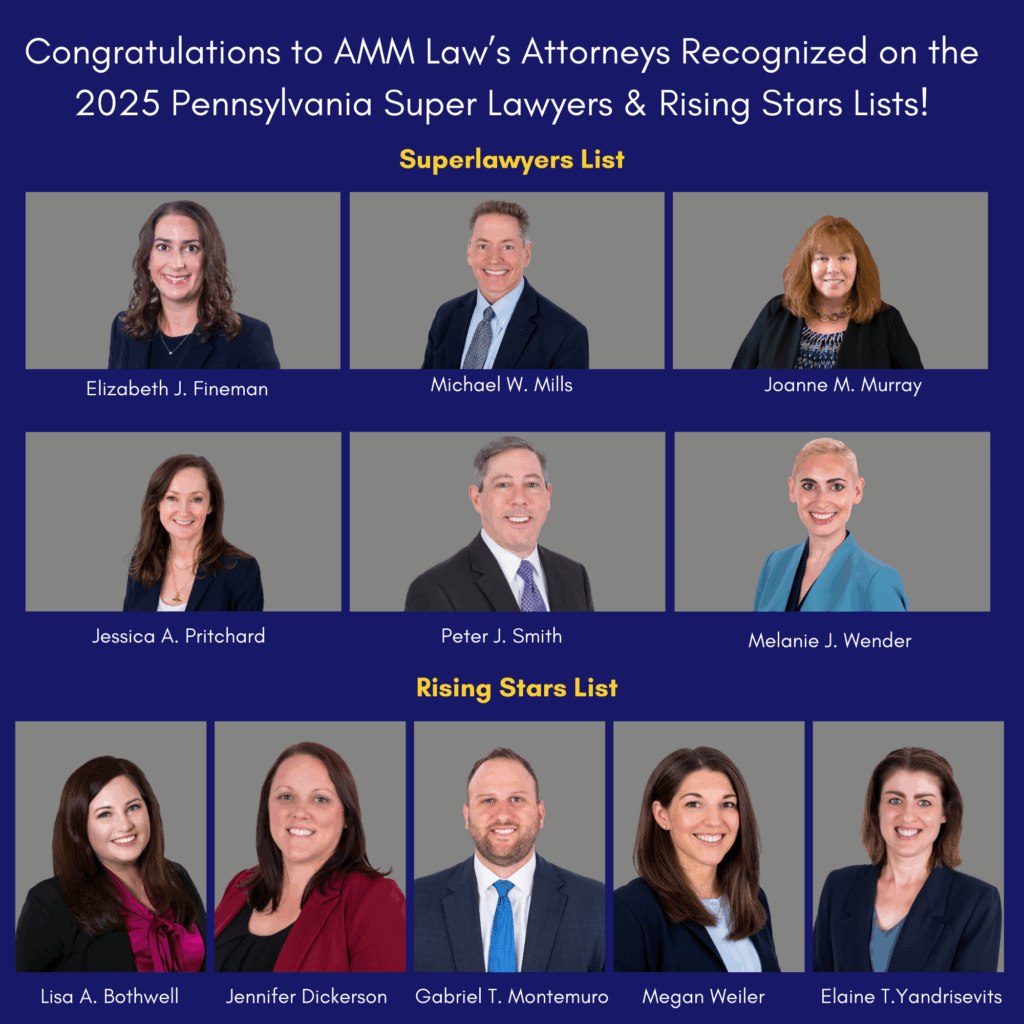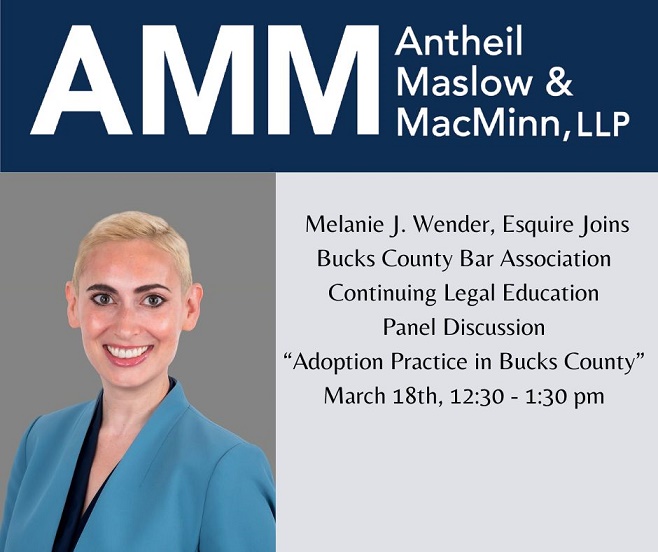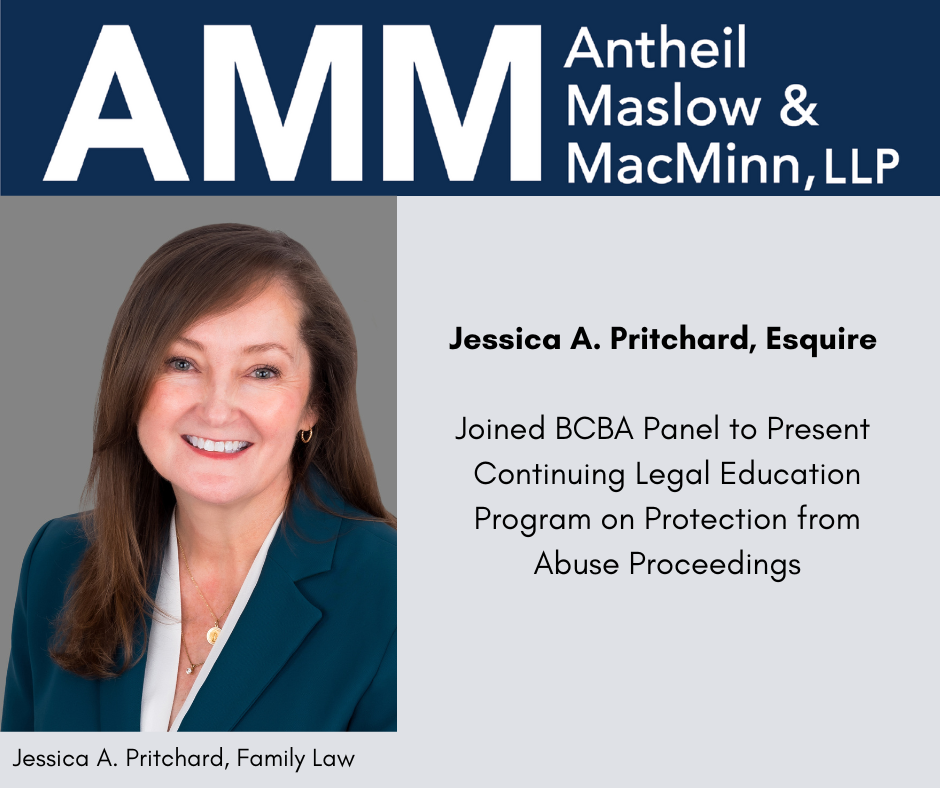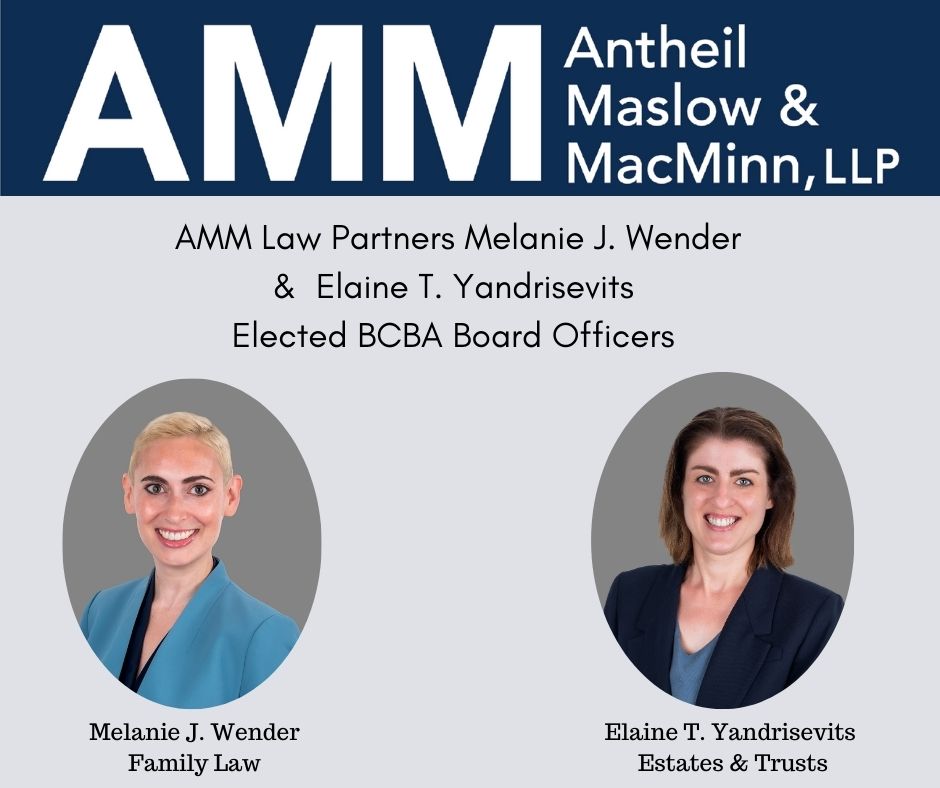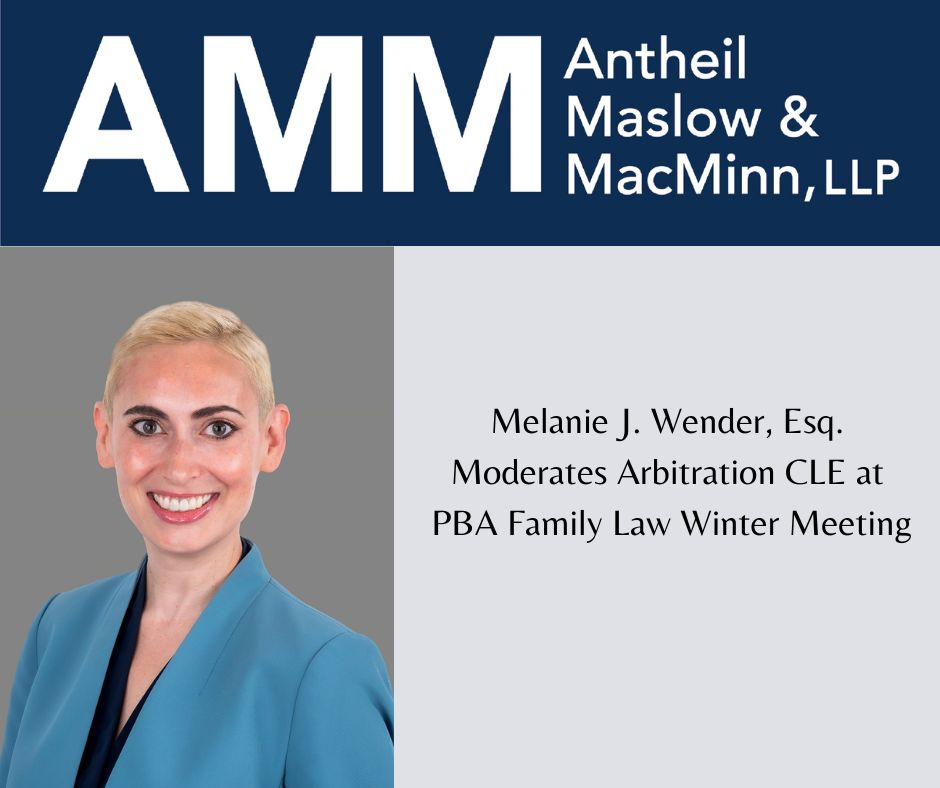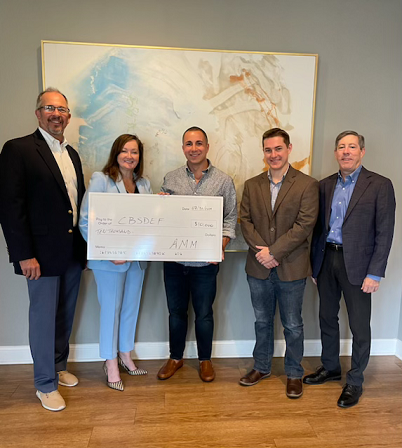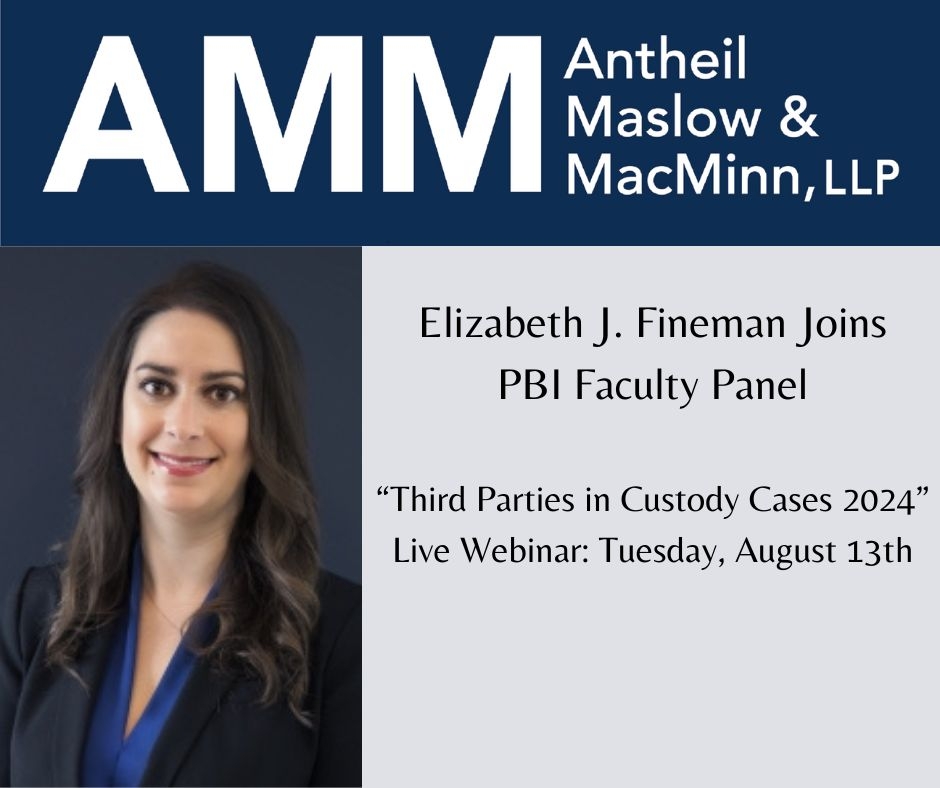Antheil Maslow & MacMinn, LLP, is pleased to announce that Samuel J. DeStefano, II has joined the firm’s Business &...
AMM Law Attorneys Selected for 2025 Pennsylvania Super Lawyers/Rising Stars Listings
Antheil Maslow & MacMinn, LLP is proud to announce that eleven of the firm’s attorneys have been selected for inclusion...
Peter J. Smith Joins Panel Discussion on Exit Planning Strategies
AMM Partner and business attorney Peter J. Smith joined Joshua Anderson, AIF, CEPA of Raymond James and Associates and Luke...
AMM Law Partners Present Ethics CLE at Bucks County Bar Association
Four partners at Antheil Maslow & MacMinn, LLP (AMM Law), Lisa Bothwell, Gabriel Montemuro, Jessica Pritchard and Elaine Yandrisevits will...
Jennifer Dickerson Joins BCBA CLE Panel Discussion on Drug Trends, Treatment and Access to Service
Jennifer Dickerson, Family Law attorney with Antheil Maslow & MacMinn LLP, joined a panel of presenters at the Bucks County...
Patricia C. Collins Presents Commercial Litigation CLE at BCBA Business Law Institute
AMM Law Partner and Commercial Litigator Patricia C. Collins will present at the Bucks County Bar Association’s 7th Annual Business...
Lisa A. Bothwell Discusses Legal Tips for Selling Your Business on $4M Strategies Podcast
AMM Law Partner and Business law attorney Lisa A. Bothwell was interviewed on March 28th on the $4M Strategies podcast....
AMM Law Welcomes Abraham V. Frangie
Antheil Maslow & MacMinn, LLP, is pleased to announce that Abraham V. Frangie has joined the firm’s Business & Finance...
Melanie J. Wender, Esq. Joins BCBA Panel Discussion – Adoption Practice in Bucks County
AMM Law Partner and Family Law attorney Melanie J. Wender will serve as a panelist at a Bucks County Bar...
Susan Maslow Authors Article for Business Law Today
Susan Maslow, member of the Responsible Investor Model Clauses Task Force of the ABA Business Law Section, Corporate Sustainability Law...
Jennifer Dickerson Presents at BCBA Family Law Section CLE
Jennifer Dickerson, Family Law attorney with Antheil Maslow & MacMinn LLP, will join a panel of presenters at the Bucks...
Jessica Pritchard Joins BCBA Panel on Protection from Abuse Proceedings
Partner and Family Law attorney Jessica Pritchard of Antheil Maslow & MacMinn, LLP joined a panel of presenters at a...
AMM Law Partners Elected BCBA Board Officers
On Thursday, December 12th, AMM Law Partners Melanie J. Wender and Elaine T. Yandrisevits were elected to Board Offices at...
Melanie J. Wender Moderates Arbitration CLE at PBA Family Law Winter Meeting
AMM Law Partner and Family Law attorney Melanie J. Wender will serve as moderator for a Continuing Legal Education...
Elaine Yandrisevits Discusses Trusts and Estates Legal Practice on PBA Real Property & Probate Podcast
Elaine Yandrisevits, AMM Law Partner and Trusts and Estates attorney was interviewed on November 3rd for the new Pennsylvania Bar...
Patricia Collins Serves as Panelist on Employment Law at 2024 BCBA Bench Bar Conference
On September 20, 2024, AMM Law Partner Patricia C. Collins, Esq. served as a panelist at the Bucks County Bar...
Susan Maslow Presents at ABA Business Law Meeting
Antheil Maslow & MacMinn, LLP founder and Partner Susan Maslow participated as part of a two-person panel at the ABA...
Antheil Maslow & MacMinn, LLP Makes Donations Supporting BCEF and BCCCF
AMM Law Partners Thomas Donnelly, Peter Smith and Jessica Pritchard presented contributions of $10,000 each to support education in Bucks...
Antheil Maslow & MacMinn, LLP Names New Partners
Antheil Maslow & MacMinn, LLP is pleased to announce that four associates have been named as partners of the firm....
Jocelin Price Named President of Bucks County Estate Planning Council
Jocelin A. Price, a Partner of the firm, will be the new President of the Bucks County Estate Planning Council....
Elizabeth J. Fineman Joins Faculty Panel at PBI Custody Program
AMM Law Partner and Family Law attorney Elizabeth Fineman will participate as faculty at the upcoming Pennsylvania Bar Institute Continuing...
Melanie J. Wender Appointed to PBA Family Law Section Council
Antheil Maslow & MacMinn, LLP (AMM Law) Family Law attorney Melanie J. Wender was appointed to the Pennsylvania Bar Association’s Family Law Section Council at the July 11th Summer meeting held at the Hyatt Regency Chesapeake in Cambridge, Md.
Gabriel Montemuro Selected to Pennsylvania Bar Association’s Leadership Institute
Antheil Maslow & MacMinn, LLP, (AMM Law) is proud to announce that Gabriel T. Montemuro has been selected to the Pennsylvania Bar Association’s Leadership Institute Class of 2024-25. According to the Pennsylvania Bar Association’s website, “The criteria for application is a demonstration of leadership ability in some capacity, a willingness to make the time commitment to the ten-month program and age 40 years or younger or have practiced five years or less.”
AMM Law Welcomes Adam M. Weiss
Antheil Maslow & MacMinn, LLP, (AMM Law) is pleased to announce that Adam M. Weiss has joined our Business & Finance practice group. Adam focuses his practice on business and corporate law, serving as a valued partner to owners and key leadership of closely held businesses in a variety of commercial and real estate transactions. With experience across the full range of business owners’ legal needs, Adam provides his clients with strategic advice to reduce risk and meet their goals throughout the life cycle of the business. Adam advises businesses on all aspects of corporate and commercial transactions including formation, mergers and acquisitions, financing, joint ventures, commercial agreements, real estate transactions, and business succession planning.


